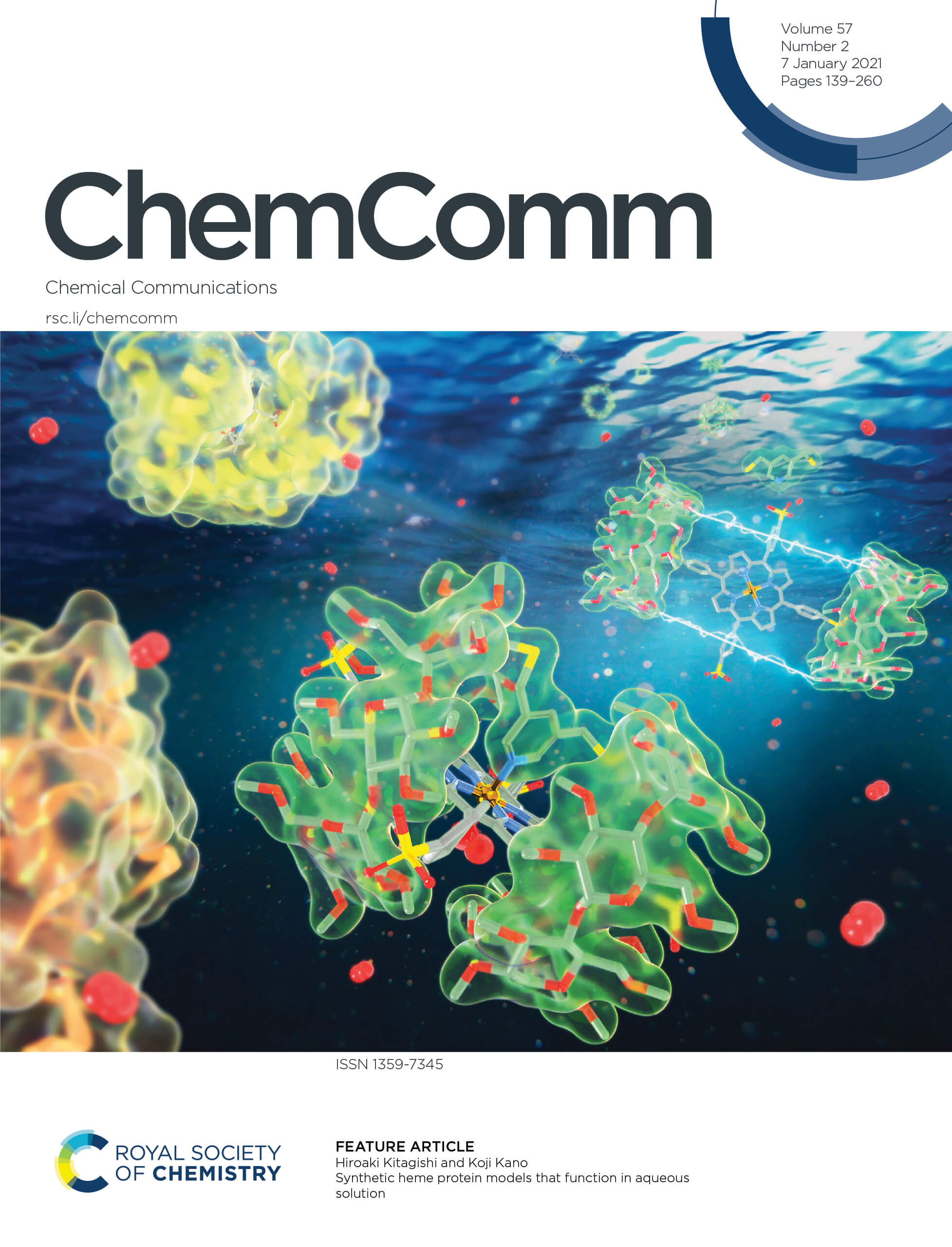論文雑誌「Chemical Communications」のカバーアートを制作しました[同志社大学]
弊社で制作しました同志社大学 北岸宏亮先生のカバーアートが
イギリスの王立化学会発行の学術雑誌 Chemical Communications
2021年1月号のFront Coverに選ばれました。

Client
同志社大学
理工学部機能分子・生命化学科
北岸 宏亮 先生
理工学部機能分子・生命化学科
北岸 宏亮 先生
Journal
Chemical Communications
07 January 2021, Issue 2, Page 139 to 260 Link
07 January 2021, Issue 2, Page 139 to 260 Link
Synthetic heme protein models that function in aqueous solution
Hiroaki Kitagishi and Koji Kano
Abstract
Myoglobin (Mb) is considered as the optimal system for capturing molecular oxygen (O2) in aqueous solution under natural conditions. Therefore, the preparation of artificial systems that mimic the function of Mb is a long-standing and challenging objective. Various sophisticated iron porphyrins have been designed and synthesized to realize O2 biding at their axial positions. Although all of these compounds reversibly bind O2 in absolute organic solvents, no stable O2 adducts were obtained in aqueous solution. The reason for this is the immediate autoxidation of O2 adducts by water molecules. To achieve O2 binding in aqueous solution, the iron center of the porphyrin must be placed in a hydrophobic environment, wherefrom a water molecule is strictly excluded. Another essential requirement for a Mb model is the preparation of an electron-donative axial ligand that plays the role of proximal histidine (His). As an artificial O2 receptor that satisfies these challenging requirements, a supramolecule termed “hemoCD1” has been constructed. HemoCD1, a 1 : 1 inclusion complex of 5,10,15,20-tetrakis(4-sulfonatophenyl)porphinatoiron(II) (FeIITPPS) with a per-O-methylated β-cyclodextrin dimer bearing a pyridine linker (Py3CD), reversibly binds O2 in aqueous solution at neutral pH and ambient temperature. The electronic spectra as well as the functions of hemoCD1 are analogous to those of Mb or its tetramer, hemoglobin (Hb). This is the first example of an artificial Hb/Mb biomimetic model capable of function in aqueous solution. Such a study on hemoCD1 as a Hb/Mb model has expanded research objectives to (1) syntheses of hemoCD1 analogues having distinct characteristics, (2) modeling enzymatic reactions of peroxidase, heme oxygenase, and cytochrome c oxidase in water, (3) development of fully synthetic artificial oxygen carriers (AOCs) utilized in animal blood, and (4) selective binding and removal of toxic small molecules, such as carbon monoxide (CO) and cyanide (CN−) in living organisms.
Chem. Commun., 2021,57, 148-173 Link
Hiroaki Kitagishi and Koji Kano
Abstract
Myoglobin (Mb) is considered as the optimal system for capturing molecular oxygen (O2) in aqueous solution under natural conditions. Therefore, the preparation of artificial systems that mimic the function of Mb is a long-standing and challenging objective. Various sophisticated iron porphyrins have been designed and synthesized to realize O2 biding at their axial positions. Although all of these compounds reversibly bind O2 in absolute organic solvents, no stable O2 adducts were obtained in aqueous solution. The reason for this is the immediate autoxidation of O2 adducts by water molecules. To achieve O2 binding in aqueous solution, the iron center of the porphyrin must be placed in a hydrophobic environment, wherefrom a water molecule is strictly excluded. Another essential requirement for a Mb model is the preparation of an electron-donative axial ligand that plays the role of proximal histidine (His). As an artificial O2 receptor that satisfies these challenging requirements, a supramolecule termed “hemoCD1” has been constructed. HemoCD1, a 1 : 1 inclusion complex of 5,10,15,20-tetrakis(4-sulfonatophenyl)porphinatoiron(II) (FeIITPPS) with a per-O-methylated β-cyclodextrin dimer bearing a pyridine linker (Py3CD), reversibly binds O2 in aqueous solution at neutral pH and ambient temperature. The electronic spectra as well as the functions of hemoCD1 are analogous to those of Mb or its tetramer, hemoglobin (Hb). This is the first example of an artificial Hb/Mb biomimetic model capable of function in aqueous solution. Such a study on hemoCD1 as a Hb/Mb model has expanded research objectives to (1) syntheses of hemoCD1 analogues having distinct characteristics, (2) modeling enzymatic reactions of peroxidase, heme oxygenase, and cytochrome c oxidase in water, (3) development of fully synthetic artificial oxygen carriers (AOCs) utilized in animal blood, and (4) selective binding and removal of toxic small molecules, such as carbon monoxide (CO) and cyanide (CN−) in living organisms.
Chem. Commun., 2021,57, 148-173 Link
